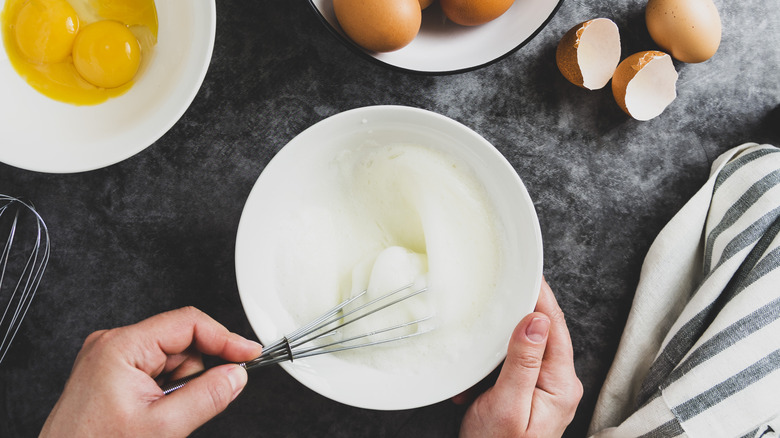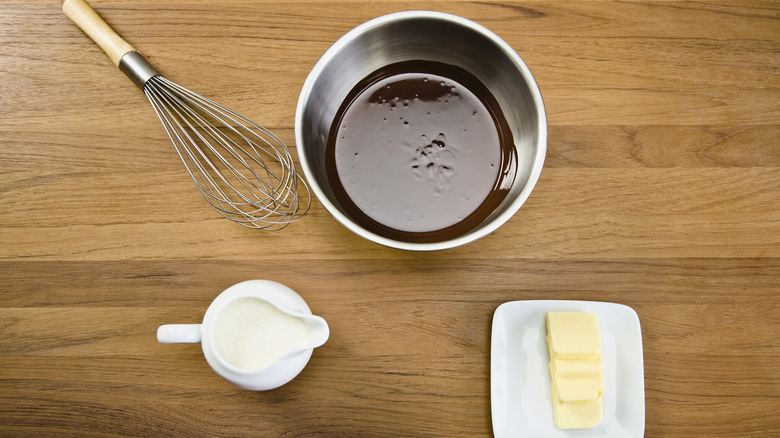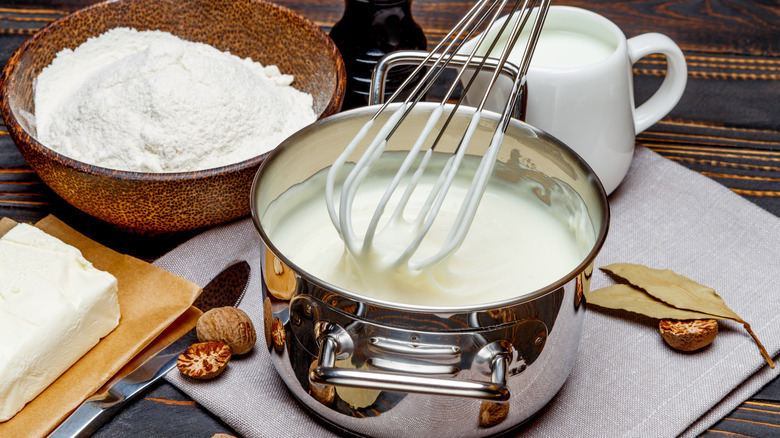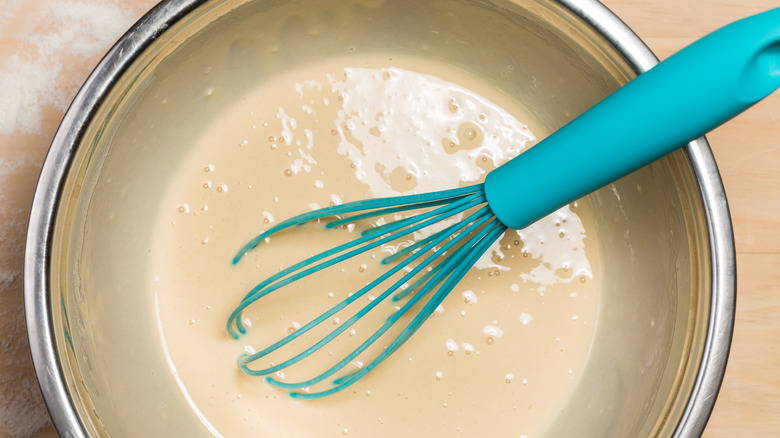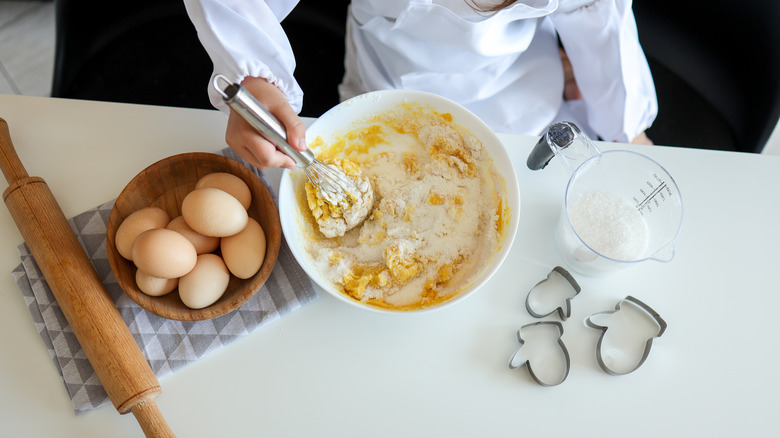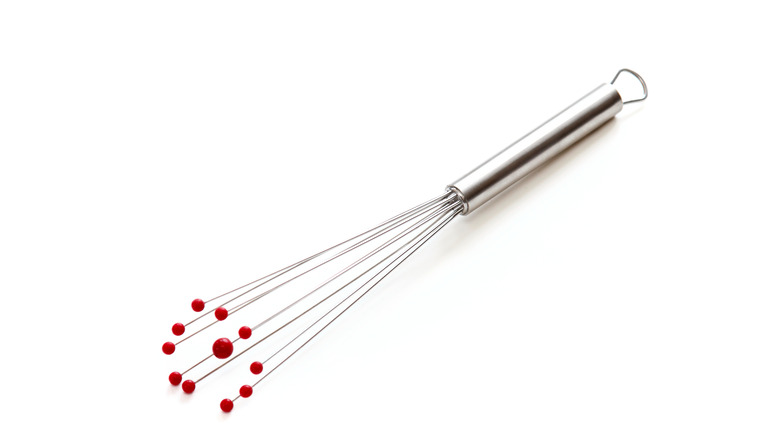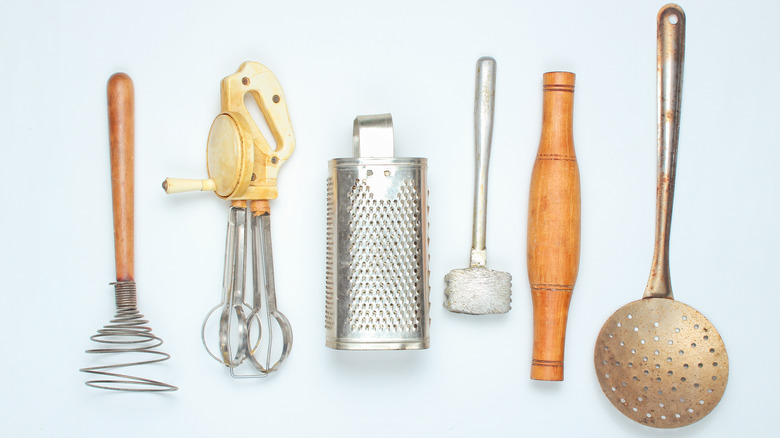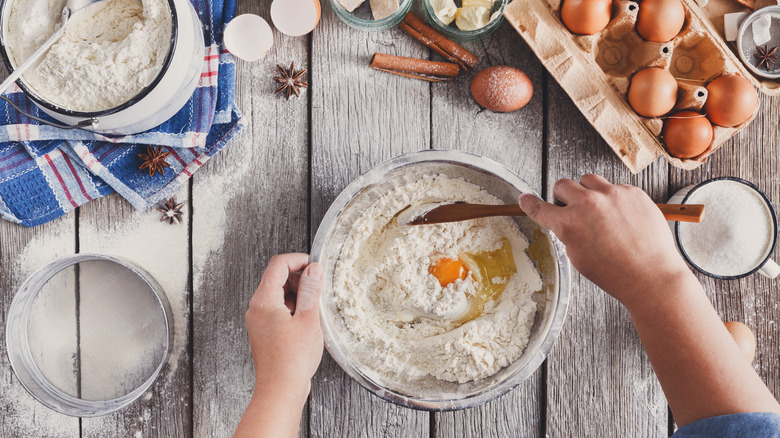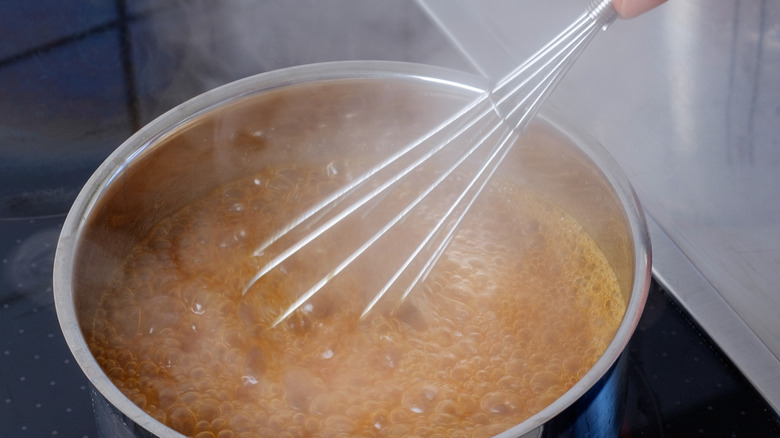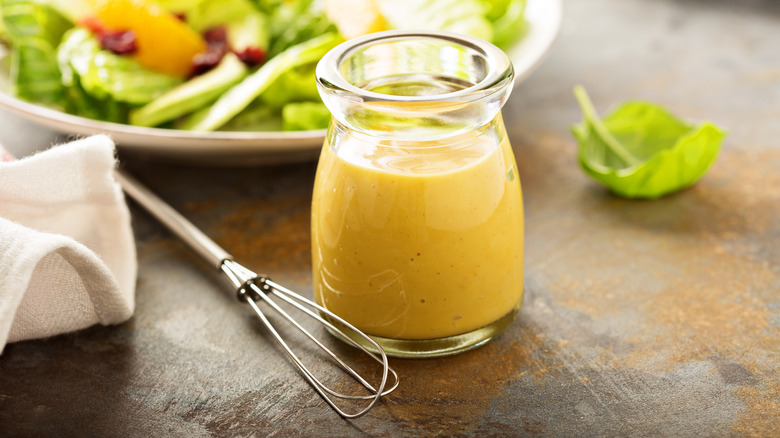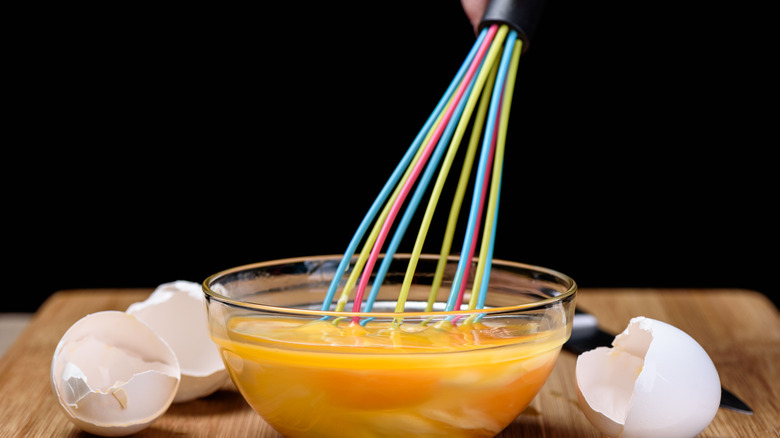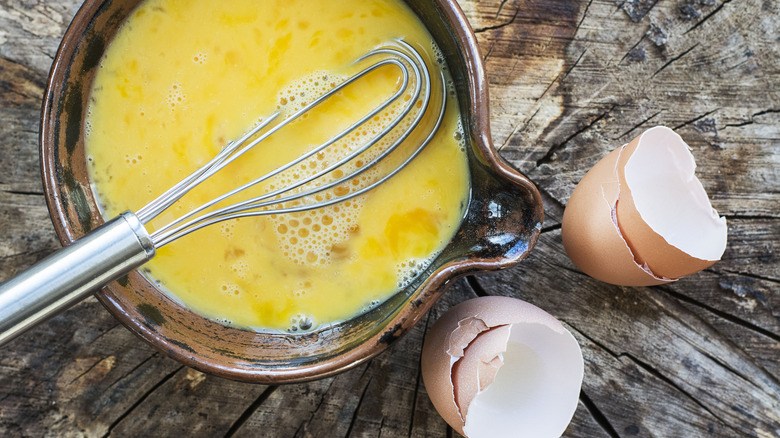A Beginner's Guide For Picking The Right Type Of Whisk For Every Dish
We may receive a commission on purchases made from links.
Don't reach for the spoon, grab a whisk instead. Whether you're scrambling a couple of eggs, mixing up some pancake batter, or whipping up a cake frosting, there's always a whisk you can use to help you mix an ingredient in a bowl. According to BBC Good Food, whisks are utensils used by professional and home chefs to combine ingredients and aerate any mixture.
Whisks are essential tools that are available in an array of styles. Unique designs and shapes contribute to how useful these tools are in the kitchen. The whisking options are endless. Select from a range of whisks that make adding volume to food while combining more than one ingredient seem like a piece of cake.
Whether you have a few whisks already or none at all, simplify finding the perfect whisk for the dish by narrowing down the options. There are several variations of whisks with individual features and materials to consider before just picking any to stir with. The whisk you select is ultimately determined by several factors ranging from the texture of the ingredients you are baking with to what is most comfortable holding in your hand.
While all whisks may whisk, they don't all whisk the same way. If you'd like to whip up a dish in the kitchen with confidence, all you need is a guide to each type of whisk and its benefits.
Balloon whisk
In all probability, most kitchens are stocked with a very familiar kind of whisk. There are favorable odds you may have even used it before or, at the very least, thought of using it. A balloon whisk is the most common type of whisk out there.
The hand-mixing tool became wildly popular during the 1960s when Julia Childs demonstrated its significance in the kitchen (via Smithsonian). This style of whisk consists of several steel tines or plastic wires connected at the handle and curved in such a way that it leaves the bottom bulbous, like a balloon.
A balloon whisk is ideal for whipping or frothing cream, eggs, sauces, and most batters. It's this very tool that is often used to turn milk into cream. The elongated shape and well-balanced design of a balloon whisk give it the ability to introduce a generous amount of air into a mixture (via Food Network). The additional air blended into the liquid results in a smooth textured finish that often leaves the concoction lighter and fluffier.
The balloon-shaped stirrer is suitable for hot or cold cooking conditions and can be used with most cookware types, depending on the material that the whisk is made of. Most balloon whisks are customarily made of metal or silicone material. Nevertheless, a good indicator of a great balloon whisk can be judged by the sturdiness of its tines. The less flexible they are, the less work you do!
French whisk
A French whisk is another multifaceted hand mixer to have at your disposal in the kitchen. This manual blender is similar to a balloon whisk in its composition. The two whisks have rounded silhouettes, making them appear almost similar. While a French whisk may look like a mini balloon whisk, these two stirrers are totally different. There are slight variations to help you tell them apart.
You can easily spot a French whisk based on how it looks and how it feels. It's typically crafted with heavier metals put together in a more narrowed profile, as seen on this one available at Crate and Barrel. The overall compact size and slender structural aspects of a French whisk are the features that enable it to be ideal for using in a multitude of mixtures.
It can certainly whip air into eggs and other delicate combinations, but it's also an expert tool to use for dense mixtures. It has slightly less bendy tines and a smaller composition that makes it ideal for batters, custards, and puddings.
As pastry chef Caroline Schiff told Saveur, French whisks are perfect for thick batters and béchamel sauces. Schiff also admits to using this whisk for making mashed potatoes. The heavier weight of the handle coupled with the slender top design makes the French whisk an ideal hand whip for more than one reason. The stirrer is great for thicker recipes but also for mixing smaller batches of batter in tinier containers.
Nonstick whisk
Investing in pots and pans is serious business, especially if you frequently cook at home. The hardware you use alongside the pots and pans should be equally as important as it's best to avoid any cookware getting peeled, scratched, or scraped.
While some markings are due to wear and tear, the utensils you use shouldn't be a contributing factor. To extend the lifespan of your most used saucepans and mixing bowls, consider switching up what you stir your mixtures, especially if they're made of materials that could be ruining them. Reach for the nonstick whisk rather than using the trusty old metal spoon or spatula.
This specific type of whisk is coated with a special layer of silicone. The extra coating helps prevent any damage to the bottoms of the cookware from whisking. A silicone-coated whisk keeps the food you are stirring from sticking to it and the pot. Also, it generally stirs quieter when it comes in contact with a metal/glass bowl or pan.
Although a nonstick whisk is useful, you may find it more laborious to use for combining thicker mixtures (as per Cully's Kitchen). If you use one, you may soon find out that nonstick whisks are typically more flexible compared to their metal alternatives. The bendier whisk is best utilized for creating vinaigrettes, marinades, and diluted sauces. Nonstick whisks are available in most whisk types, from flat to balloon.
Spiral whisk
When you are cooking a sauce or gravy, it's common to reach for a spoon to get all the bits and pieces at the bottom of the pot and all around the edges, too. But try to ditch the metal, wood, or plastic spoon and replace it with a whisk. Try adding a spiral whisk to your kitchen arsenal.
The twisty-style whisk is similar to a spoon in its circular shape and stirring capability, but it's potentially a better mixing tool overall. While you may not be able to eat soup with it, a spiral whisk does an excellent job reaching the crevices typically missed by the latter.
A spiral whisk is composed of a rounded tight coil that is flat. The spiral whisk's single coil is twisted around a curved tine that is attached to the handle, as visible on this one available on Amazon. The leveled form allows for mixing and aerating to take place at the same time. It's an ideal kitchen tool for making sauces. You may even know it as a sauce whisk.
The ring-shaped coil head makes it a perfect utensil for stirring that prevents liquids from sticking as well as promoting the thickening of the mixture, according to Gourmet Kitchenworks. The spiral whisk's rounded shape and variable size reaches into pots and bowls with ease. A spiral whisk is ideal when a balloon shape whisk would be too bulky. It is a great gadget for mixing dry and wet ingredients.
Ball whisk
Every mash-up doesn't require extensive time to mix it all together. Certain mixtures need just a couple of twirls to be evenly combined. If this sounds like a dish that you might be creating, then this whisk might be ideal for you. For a quick whip, reach for a ball whisk. If you need to whisk something delicately, then a ball whisk can easily become a new go-to kitchen tool.
This variety of stirrer is completely different compared to the lineup of other ordinary hand mixers. Based on appearance alone, a ball whisk could be considered a rather unique one. Instead of sporting the classic curved wiring seen on a balloon or French whisk, a ball whisk is composed of straight tines sprouting outward from the handle. The wires each have small spheres attached at the very ends, as seen on this ball whisk available at WIlliams Sonoma.
Its structure isn't just for aesthetics, though, it's actually quite purposeful. A ball whisks unique design attributes to shortening of the mixing time. Since a ball whisk completely lacks the traditional rounded coils and wiring, the aeration takes place faster compared to typical whisks (as per Craftsy).
A ball whisk's distinct form, with its many spokes and spheres, is what makes it a go-to utensil for rapidly mixing together marinades, dressings, meringues, or simple syrups. However, for thicker batters, you may want to skip this style of whisk. A ball whisks design allows for maximum flexibility and movement.
Spring whisk
There is a whisk that wiggles rather than whips, and it's called a spring whisk. You may also refer to this kitchen tool as a twirl or coil whisk. Any of the names are suitable as each one stems from the apparatus' individual design.
A spring whisk is constructed using a single tine that wraps around several times in a circular form. The wrapped coil is twirled enough to give the kitchen whipper some bounce (think of a coiled spring). Regardless of what you call it, this type of whisk is great for incorporating liquids together in pots and bowls using vibrations.
As the name suggests, a spring whisk is designed to be bounced up and down to blend pancake batters, cake mixes, and similar compositions. Rather than move the utensil side to side or all around the edges of the container, the spiral whisk is maneuvered in a wiggling, up-and-down motion.
According to Joy the Baker, the twisted coils on this instrument are ideal for blending extensive mixtures that need vigorous emulsifying. The springing motion created by the spring whisk swishes the contents toward the edges while combining the ingredients easily until the desired consistency is reached. Whether you already own or purchase the wire handle or solid handle version, any of the spring whisk varieties will blend mixtures in the exact same way.
Dough whisk
If you have ever tried stirring a batter of a thick consistency or making a dough of any kind, you know all too well the triumph of getting the stuck batter off the spoon. Yet you don't have to battle the batter every time if you get your hands on the right type of whisk. Unlike a rubber spatula, dough hook, metal, or wooden spoon, there is a whisk you could use for those tough batters and times of heavy dough kneading. A dough whisk is unlike any whisk you've been introduced to thus far.
Dough whisks are expertly designed with two, sometimes three, coils. One of the wires is twisted or looped. Each of the tines is connected to a handle typically made of metal or wood. According to Serious Eats, it's the asymmetrical double loops of the dough whisk that help to bind ingredients in the bowl and prevent the compound from clumping, sticking, or separating. The stiff wiring and sturdy handle make it the perfect kitchen gadget for preparing difficult types of batter and bread dough.
According to All Recipes, a dough whisk is primarily used in the kitchen for dough making. It is, however, a useful alternative option for incorporating less strenuous mixtures like cake, pie, or muffin batters. If you plan on kneading a lot of dough by hand, then a dough whisk is perhaps the culinary creation you didn't know you needed. Combine dry and wet ingredients easily with a dough whisk.
Conical whisk
If you have ever mixed together multiple ingredients and discovered dry clumps at the bottom of the bowl or pan, then it's quite possibly time for you to consider upgrading to the right kind of whisk. The lumps in the batter could be because the stirrer you are using is not reaching every corner and edge of the bowl or pot, leaving ingredients just sitting there.
Rounded whisks, even flat ones, aren't exactly the best cooking utensil for getting into those hard-to-reach places. Try to hold off on reaching for the spoon or rubber spatula just yet. There is a whisk that may be better at getting the tedious task of scraping in the crevices done.
Perhaps a conical whisk is what's missing from the stirrers in the drawer. Instead of having many wires that loop back to the handle, creating a curved form. This style of whisk is known for having narrow wires that form a point. The unusual construction of the wires allows the utensil to take on a diamond form (via Webstaurantstore).
The whisk's structure still whips and mixes, eliminating any lumps in the batter or blend, except this mixing tool can reach the parts of the pan a bulky, round whisk typically misses. The sleek form of this whisk makes it a sturdy stirring tool great for mixing any kind of batter, thick or thin. Give it a whirl, and try mixing the next batter with a conical whisk.
Minibar whisk
How do you like your drink, stirred or shaken? If you have the right whisk, then odds are you already know the answer to that question. If you have a minibar, coffee, or bar cart area in your home, then you are no stranger to mixing cocktails or crafting delicious cups of brew.
As you know, these types of beverages sometimes require mixing up before enjoying the first perfect sip. If you adore a frothy coffee or well-fused drink, then this hand mixer is a must-have whipper for the house. Resist the urge, leave the spoon in the drawer and grab a mini-bar whisk instead.
A minibar whisk would be the perfect drink stirrer to add to the beverage cart or coffee station in your home. It definitely lives up to its name with its compact design and mini size. It has a slender handle with curved tines similar to a balloon whisk, except much smaller! This specific style of hand whisk is meant for stirring individual drinks that are hot or cold (as per Delighted Cooking).
The small-sized whisk fits easily into mugs and glasses, making it simple to aerate drinks for a smooth or frothy finished texture. It also helps that the whisk's more compact design makes it very easy to store when it's not in use.
Tornado whisk
A ball whisk is not the only extraordinary stirrer available on the market. The tornado whisk is for the sort of stirrers who like their utensils as useful yet just as colorful and equally as unique as their personality. If you are able to get your hands on this one-of-a-kind whisk, then consider yourself a lucky duck! The tornado whisk is a brightly colored, twisted stirrer that whips almost any mixture of varying consistency with fierce effortlessness.
A tornado whisk, as the name so clearly suggests, is shaped similarly to a funnel. The narrowest part of the wiring is at the handle, with the widest portion at the opposite end. The fundamental difference with the tornado tool as compared to other whisks if the funnel design allows for the bottom of the whisk to be completely flat and wide.
As such, the tornado whisk is able to reach the bottom of the bowl and all the surrounding edges easily. The unique twisted tines make blending a breeze. Not only can the tornado whisk blend and smooth any sauce, gravy, cream, or batter, but the fun colored kitchen tool bonuses as eclectic kitchen decor. A tornado whisk, which is available at Walmart, is safe to use on all varieties of cookware and easy to clean.
Flat whisk
If you are attached to your spatula and swear it's the last kitchen tool you will ever need, you haven't tried cooking with a flat whisk yet. The wires on this utensil are not shaped in the circular form found on most other whisks. The food flipper is composed of several sets of wires that are attached near the handle.
Each tine is a different size and is bent into a distinct u-shape. A flat whisk, like the one available at Crate and Barrel, is ideal for scrapping, mixing, and flipping food. Southern Living notes that the unique shape of a flat whisk doubles as a spatula, making it useful for stirring pancake batter and then flipping the flapjacks. Use a flat whisk to mix up sauces or turn over omelets. A flat whisk could be what's missing in your kitchen as its versatility extends beyond that other old food turner.
Forks and spoons are not designed for specifically mixing foods. Whisks are typically easier to use when it comes to blending or beating ingredients together. These hand blenders are crafted just for this purpose! Which whisk you use depends upon what components are being combined in the recipe you chose, plus the features of the whisk itself. Pick your favorite whisk or try a few new ones. Upgrade the gadgets you have in your kitchen to ensure that you have the right type of whisk for every dish.
